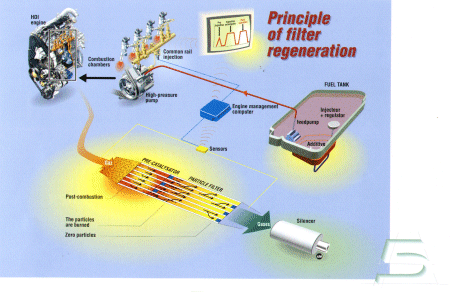|
||||||||||||||||||||||
PSA Peugeot CitroŽn creates a 5th stroke for the diesel engine |
 |
|
In line with a commitment made in 1998, PSA Peugeot CitroŽn will introduce the first particle filter system (PF) to be fitted as standard, from early 2000, when they will launch the new engine heading up the family of HDi "common rail" high-pressure direct-injection power units in one of the group's vehicles for the future. By eliminating particles and smoke the PF system will further enhance the advantages the diesel engine enjoys on the score of environmental protection. A diesel engine inherently uses less fuel than a petrol engine and therefore emits less greenhouse gas. This plus-quality is compounded in the HDi engine which in comparison with a classic diesel unit further reduces CO2 by 20%, CO by 40%, hydrocarbons by 50% and particles by 60%. At the same time it offers even more enjoyable motoring. Developed over 18 months, the PF system was brought to fruition thanks to the "common rail" system in the HDi engine which, by its principle of operation, allows total control of all the phases of combustion. Via the engine management system the flexibility of the "common rail" allows the filter to be regenerated, using post-combustion to modify exhaust gas temperature. Until now, the main obstacle to developing the particle filter for the car was regeneration of the filter element by combustion of particles that had been filtered out. PSA
Peugeot CitroŽn has adopted a technical solution which offers efficient
regeneration, unnoticeable by drivers and needing no action on their
part, yet preserving the pleasures of motoring whatever the conditions
of use. The PF system described It comprises
The particle filter The
particle filter is a porous silicon carbide unit, comprising
passageways which trap particles in the exhaust gases stream. It is
notable for its very high filtering efficiency and its ability to
retain particles. The principle of particle filter regeneration Regeneration consists of periodically burning up the particles accumulated in the filter element. Primarily composed of carbon and hydrocarbons, particles trapped in the filter burn in the presence of oxygen at a temperature of 550 C. Regeneration is controlled by the "common rail" injection system, which allows multiple injections to raise the initial temperature of the exhaust gases (around 150 C in urban driving) to 450 C as they leave the exhaust collector box. There are two stages to this temperature increase. A control
adapted to the injection system allows exhaust gas temperature to rise
to 450 C.
The fuel additive To
reach the regeneration threshold, the fuel receives a cerine-based
additive product, Eolys ģ, made by Rhodia, which lowers the natural
combustion temperature of the particles to 450 C. The PF system in practice Exhaust gas is continuously filtered. Depending on the filter's state of congestion, regeneration takes place every 400 to 500 km/250 to 300 miles. To
maintain its efficiency, the filter will be cleaned at dealerships
every 80 000 km/50 000 miles by high-pressure water, to get rid of
cerine deposits. A positive benefit to the environment The PF system is part of the overall strategy pursued by PSA Peugeot CitroŽn to reduce pollutant emissions. By eliminating particles and smoke it endows the HDi diesel engine with an ecological advantage in absolute terms. The
PF system allows for further improvement, thanks to complementary
catalytic post-treatment Systems lowering gaseous emission levels still
further as the quality of diesel fuel itself is improved, especially
with the sulphur content reduced to less than 30 ppm. |
|
 |
The PSA Peugeot CitroŽn group will start production of the PF system with the launch of the DW12 TED4 engine at the beginning of the year 2000. This 2,2 litre engine will develop 98 kW power and torque of 315 Nm - offering superior performance to the current 2,5 litre diesel engine. Designed to
limit the emission of pollutants, it features
|